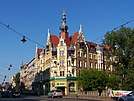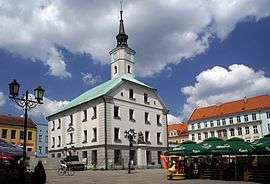Gliwice
| Gliwice | |||
|---|---|---|---|
|
Market Square • Cathedral • Gliwice Castle | |||
| |||
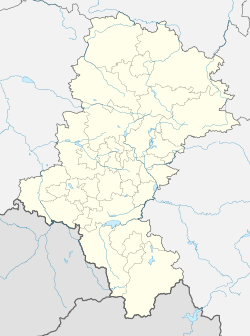 Gliwice  Gliwice | |||
| Coordinates: 50°17′N 18°40′E / 50.283°N 18.667°E | |||
| Country |
| ||
| Voivodeship |
| ||
| County | city county | ||
| Established | 13th century | ||
| Town rights | 1250 | ||
| Government | |||
| • Mayor | Zygmunt Frankiewicz | ||
| Area | |||
| • City | 133.88 km2 (51.69 sq mi) | ||
| Highest elevation | 278 m (912 ft) | ||
| Lowest elevation | 200 m (700 ft) | ||
| Population (2013) | |||
| • City | 186,347 | ||
| • Density | 1,400/km2 (3,600/sq mi) | ||
| • Urban | 2,746,000 | ||
| • Metro | 4,620,624 | ||
| Time zone | UTC+1 (CET) | ||
| • Summer (DST) | UTC+2 (CEST) | ||
| Postal code | 44-100 to 44-164 | ||
| Area code(s) | +48 32 | ||
| Car plates | SG | ||
| Climate | Cfb | ||
| Website | http://www.gliwice.eu/ | ||
Gliwice [ɡlʲiˈvʲit͡sɛ] (![]()
Gliwice is the westernmost city of the Upper Silesian metropolis, a conurbation of 1.9 million people, and is the third-largest city of this area, with 183,392 permanent residents as of 2015[1]. It also lies within the larger Upper Silesian metropolitan area which has a population of about 5.3 million people and spans across most of eastern Upper Silesia, western Lesser Poland and the Moravian-Silesian Region in the Czech Republic. It is one of the major college towns in Poland, thanks to the Silesian University of Technology, which was founded in 1945 by academics of Lwow University of Technology expelled from Soviet Ukraine in 1945-48. Over 20,000 people study in Gliwice.[2] Gliwice is an important industrial center of Poland. Following an economic transformation in the 1990s, Gliwice switched from steelworks and coal mining to automotive and machine industry. The last remaining coal mine in Gliwice was set to close before 2021, however following its good economic results this decision has been postponed.[3]
Founded in the 13th century, Gliwice is one of the oldest settlements in Upper Silesia. Gliwice's medieval old town was severely destroyed by the Red Army in World War II, however has since been rebuilt and underwent a major restoration in recent years. Gliwice's most historical structures include St Bartholomew's church (15th century), Gliwice Castle and city walls (14th century), Armenian Church (originally a hospital, 15th century) and All Saints Old Town Church (15th century). Gliwice is also known for its Radio Tower, where Gleiwitz incident happened shortly before the outbreak of World War II and which is though to be the world’s tallest wooden construction[4], as well as Weichmann Textile House, one of the first buildings designed by world-renowned architect Erich Mendelsohn.
Etymology
In Slavic languages, the root gliw or gliv suggests terrain characterized by loam or wetland. In South Slavic languages, glive or gljive refers to mushrooms, with gljivice meaning little mushrooms.
History
Early history
Gliwice was first mentioned as a town in 1276 and was ruled during the Middle Ages by the Silesian Piast dukes.[5] During the reign of Mieszko I Tanglefoot, the town was part of a duchy centered on Opole-Racibórz, and became a separate duchy in 1289.[5] According to 14th-century writers, the town seemed defensive in character and was ruled by Siemowit of Bytom.[5] The town became a possession of the Bohemia crown in 1335, passing with that crown to the Austrian Habsburgs as Gleiwitz in 1526.
Early Modern Age
Because of the vast expenses incurred by the Habsburg Monarchy during their 16th century wars against the Ottoman Empire, Gleiwitz was leased to Friedrich Zettritz for the amount of 14,000 thalers. Although the original lease was for a duration of 18 years, it was renewed in 1580 for 10 years and in 1589 for an additional 18 years.
During the mid 18th century Silesian Wars, Gleiwitz was taken from the Habsburg Monarchy by the Kingdom of Prussia along with the majority of Silesia. After the end of the Napoleonic Wars, Gleiwitz was administered in the Prussian district of Tost-Gleiwitz within the Province of Silesia in 1816. The city was incorporated with Prussia into the German Empire in 1871 during the unification of Germany. In 1897 Gleiwitz became its own Stadtkreis, or urban district.
Industrialization
The first coke-fired blast furnace on the European continent was constructed in Gleiwitz in 1796 under the direction of John Baildon. Gleiwitz began to develop into a major city through industrialization during the 19th century. The town's ironworks fostered the growth of other industrial fields in the area. The city's population in 1875 was 14,156. However, during the late 19th century Gleiwitz had: 14 distilleries, 2 breweries, 5 mills, 7 brick factories, 3 sawmills, a shingle factory, 8 chalk factories and 2 glassworks.

Other features of the 19th century industrialized Gleiwitz were a gasworks, a furnace factory, a beer bottling company, and a plant for asphalt and paste. Economically, Gleiwitz opened several banks, Savings and loan associations, and bond centers. Its tram system was completed in 1892, while its theater was opened in 1899; until World War II, Gleiwitz' theatre featured actors from throughout Europe and was one of the most famous theatres in the whole of Germany.
20th century
According to the 1911 Encyclopædia Britannica, Gleiwitz's population in 1905 was 61,324. By 1911 it had two Protestant and four Roman Catholic churches, a synagogue, a mining school, a convent, a hospital, two orphanages, and a barracks. Gleiwitz was the center of the mining industry of Upper Silesia. It possessed a royal foundry, with which were connected machine factories and boilerworks. Other industrialized areas of the city had other foundries, meal mills, and factories producing wire, gas pipes, cement, and paper.
After the end of World War I, clashes between Poles and Germans occurred during the Polish insurrections in Silesia. Some ethnically Polish inhabitants of Upper Silesia wanted to incorporate the city into the Second Polish Republic. Seeking a peaceful solution to the conflict, the League of Nations held a plebiscite on 20 March 1921 to determine which country the city should belong to. In Gleiwitz, 32,029 votes (78.7% of given votes) were for remaining in Germany, Poland received 8,558 (21.0%) votes, and 113 (0.3%) votes were declared invalid. The total voter turnout was listed as 97.0%. This prompted another illegal insurrection by Poles. The League of Nations determined that three Silesian towns: Gleiwitz, Hindenburg and Beuthen would remain in Germany, and the eastern part of Upper Silesia with its main town of Katowice (Kattowitz) would join restored Poland.
An attack on a radio station in Gleiwitz on 31 August 1939, staged by the German secret police, served as a pretext, devised by Reinhard Heydrich under orders from Hitler, for Nazi Germany to invade Poland, which marked the start of the Second World War. From July 1944 to January 1945, Gliwice was the location for one of the many sub-camps of the Auschwitz concentration camp.[6]
On 24 January 1945, Gliwice was occupied by Red Army as part of their Allied Occupation Zone. However they then illegally placed the province under Polish administration and announced it at the 1945 Potsdam Conference as a fait accompli. Most of the German population was expelled and replaced with Polish settlers expelled from eastern, previously Polish & Lithuanian lands annexed post war by the Soviet Union. It was incorporated into Poland's Silesian Voivodeship on 18 March 1945 after well over 600 years of Teutonic rule.
Demographics
Population development
The earliest population estimate of Gliwice comes from a 1750 and put population mark at 1,159 people.[7] The same source cites population to be 2,990 in 1810, 6,415 in 1838, and 10,923 in 1861. A census from 1858 reported the following ethnic makeup: 7,060 - German, 3,566 - Polish, 11 - Moravian, 1 - Czech. Since the Industrial Revolution, Gliwice saw rapid economic growth which fuelled fast population increase. In 1890 Gliwice had 19,667 inhabitants, and this number has increased over twofold over the next 10 years to 52,362 in 1900.[8] Gliwice gained its status of a large city (Großstadt in German) in 1927, when population reached 102,452 people.
In 1945, with the approaching Red Army a significant number of residents were either evacuated or fled the city at their own discretion. Following the Yalta Conference, Gliwice, along most of Silesia, was incorporated into communist Poland, and the remaining German population was expelled. Ethnic Poles, themselves expelled from the Polish Kresy (which were incorporated into Soviet Union), started to settle down in Gliwice. Population estimates reached their pre-war levels in 1950, at 119,968 people. Gliwice's population peaked in 1988 at 223,403 inhabitants.
As of December 31st, 2016, Gliwice's population stood at 182,156 people, a decrease of 1,236 over the previous year. Gliwice faces a continuous population decline since 1988, which is credited to very low birth rates (exceeded by death rates) and suburbanisation.

Nationality, ethnicity and language
Historically, Gliwice was ethnically diverse, with a German majority. In the Upper Silesian Plebiscite in 1921, 78.9 percent of voters opted for Germany (however 15.1 percent of vote in Gliwice was cast by not-residents, who are believed to overwhelmingly vote for Germany across the region). However in 1945 most of Germans were expelled or fled themselves, and the city was repopulated with expatriates, mostly from Eastern Poland. Many of these new inhabitants were academics from the Lwow Polytechnic who created the Silesian University of Technology.
According to the 2011 Polish Census, 93.7 percent of people in Gliwice claimed Polish nationality, with the biggest minorities being Silesians at 9.7 percent (18,169 people) and Germans at 1.3 percent (2,525). 0.3 percent declared another nationality, and the nationality of 2.1 percent of people could not be established.[9] These numbers do not sum up to 100 percent as responders were allowed to choose up to two nationalities. Most-common languages used at home were: Polish (97.7 percent), Silesian (2.3 percent), German (0.7 percent) and English (0.4 percent).[9]
Religion
Except for a short period immediately after Reformation, Gliwice has always had a Catholic majority, with sizeable Protestant and Jewish minorities. According to the population estimate in 1861, 7,476 people (68.4 percent) were Catholic, 1,555 (14.2 percent) Protestant, and 1,892 Jewish (17.3 percent, highest share in city history).[7][10]
Currently, as of 2011 census, 84.7 percent of inhabitants claim they belong to a religion. The majority - 82.73 percent - belongs to the Catholic Church. This is significantly lower than the Polish average, which is 89.6 and 88.3 percent, respectively. According to the Catholic Church in Poland, weekly mass attendance in the Diocese of Gliwice is at 36.7 percent of obliged, on par with Polish average.[11] Other larger denominations include Jehovah's Witnesses (0.56 percent or 1,044 adherents) and Protestants (0.37 percent or 701 adherents).[9]
Gliwice is the seat of the Roman Catholic Diocese of Gliwice, which has 23 parish churches in the city. Gliwice is also the seat of the one of the three Armenian Church parishes in Poland (the other being in Warsaw and Gdańsk), which is subject to the Holy See directly. Other denominations present in the city include: a Greek Catholic Church parish, a Evangelical Church of Augsburg Confession parish, a Methodist parish, 9 Jehovah Witnesses halls (including one offering English-language services), several evangelical churches, a Buddhist temple and a Jewish prayer house.
Jews in Gliwice
Gliwice's Jewish population reached its highest number in 1929 at approx. 2,200 people, and started to decline in late 1930s, as NSDAP gained power in Germany. In 1933 there was 1,803 Jews in the city, and this number has dropped by half to 902 in 1939, most of them perished in the war. Between 1933 and 1937, Jews of Upper Silesia enjoyed somewhat less legal persecution compared to Jews in other parts of Germany, thanks to the Polish-German Treaty of Protection of Minorities' Rights in Upper Silesia. This regional exception was granted thanks to a lawsuit that Gliwice citizen Franz Bernheim filed against Nazi Germany in front of the League of Nations.[12][13]
Only 25 Jews of the pre-war population lived through the war in the city, all of them being in mixed marriages with gentiles.[14] Immediately after the war, Gliwice became a congregation point for Jews saved from The Holocaust, with population at around a 1,000 people in 1945. Since then, the number of Jews in Gliwice has started to decline as survivors moved to larger cities or emigrated to Israel, United States and other western counties.[10] Currently, Gliwice's Jewish community is estimated at around 25 people and is part of the Katowice Jewish Religious Community.
Gliwice has one Jewish prayer house, where religious services are held every Sabbath and on holidays. It is located in the house that the Jewish Religious Community elected in 1905. Previously, Jews in Gliwice prayed in the New Synagogue which was destroyed by nazis during the Kristallnacht in 1938.
Notable members of the Jewish community in Gliwice include:
- Oscar Troplowitz (1863-1918) - German pharmacist, owner of Beiersdorf AG and inventor of Nivea Creme
- Eugen Goldstein (1850-1930) - German physicist, discoverer of anode rays, sometimes credited for discovery of the proton
- Julian Kornhauser, (b. 1946) - Polish poet and father of current first lady Agata Kornhauser-Duda, was born in Gliwice in 1946 to a Jewish father and Silesian mother.
Higher education and science
Gliwice is a major applied science hub for the Upper Silesian Metropolitan Union. Gliwice is a seat of:
- Silesian University of Technology with about 32,000 students (Politechnika Śląska)
- Akademia Polonijna of Częstochowa, branch in Gliwice
- Gliwice College of Entrepreneurship (Gliwicka Wyższa Szkoła Przedsiębiorczości)[15]
- Polish Academy of Sciences (Polska Akademia Nauk)
- Institute of Theoretical And Applied Informatics
- Institute of Chemical Engineering
- Carbochemistry branch
- Other (commercial or government funded) applied research centers:
- Oncological Research Center (Centrum Onkologii)
- Inorganic Chemistry Research Institute (Instytut Chemii Nieorganicznej)
- Research Institute of Refractory Materials (Instytut Materiałów Ogniotrwałych)
- Research Institute for Non-Ferrous Metals (Instytut Metali Nieżelaznych)
- Research Institute for Ferrous Metallurgy (Polish: Instytut Metalurgii Żelaza)
- Welding Research Institute (Instytut Spawalnictwa)
Water transport
The Gliwice Canal (Kanał Gliwicki) links the harbour to the Oder River and thus to the waterway network across much of Germany and to the Baltic Sea. There is also an older Kłodnica Canal (Kanał Kłodnicki) which is no longer operational.
Sports
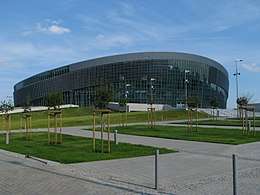
- Piast Gliwice – men's football team playing in Orange Ektraklasa (since season 2008/2009),
- Carbo Gliwice – men's football team,
- Sośnica Gliwice – women's handball team playing in Polish Ekstraklasa Women's Handball League: 10th place in 2003/2004 season.
- Gliwickie Towarzystwo Koszykówki – men's basketball team.
- P.A. Nova Gliwice – men's futsal team playing in 1st league (4 times Champion of Poland).
- Gliwice Cricket Club[16]
- K.S. Kodokan Gliwice [17] - martial arts team and club.
- Gliwice LIONS [18] - American Football team.
Politics
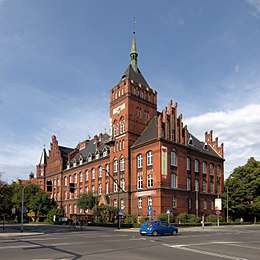
President of the city (i.e. Mayor) is Zygmunt Frankiewicz. Gliwice has 21 city districts, each of them with its own Rada Osiedlowa. They include in alphabetical order: Bojków, Brzezinka, Czechowice, Kopernik, Ligota Zabrska, Łabędy, Obrońców Pokoju, Ostropa, Politechnika, Sikornik, Sośnica, Stare Gliwice, Szobiszowice, Śródmieście, Żwirki I Wigury, Trynek, Wilcze Gardło, Wojska Polskiego, Wójtowa Wieś, Zatorze, Żerniki.
Bytom/Gliwice/Zabrze constituency
Members of Parliament (Sejm) elected from Bytom/Gliwice/Zabrze constituency include: Brzeziński Jacek (PO), Chłopek Aleksander (PiS), Gałażewski Andrzej (PO), Głogowski Tomasz (PO), Kaźmierczak Jan (PO), Martyniuk Wacław (LiD), Religa Zbigniew (PiS), Sekuła Mirosław (PO), Szarama Wojciech (PiS), Szumilas Krystyna, (PO).
Buildings
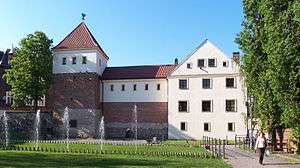
- The Gliwice Radio Tower of Radiostacja Gliwicka ("Radio Station Gliwice") in Szobiszowice is the only remaining radio tower of wood construction in the world, and with a height of 118 meters, is perhaps the tallest remaining construction made out of wood in the world.
- Gliwice Trynek narrow-gauge station is a protected monument. The narrow-gauge line to Racibórz via Rudy closed in 1991 although a short section still remains as a museum line.
- Castle in Gliwice dates back to the Middle Ages and hosts a museum.
International relations
Twin towns—Sister cities
Gliwice is twinned with the following cities:
Notable people
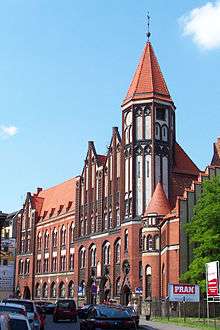
- John Baildon, Scottish engineer
- Richard Fritz Behrendt, German sociologist
- Horst Bienek, German author of novels about Upper Silesia
- William Blandowski, zoologist, photographer
- Sebastian Boenisch, Polish-German footballer who plays for the Poland national football team
- Lothar Bolz, foreign affairs minister of the communist German Democratic Republic
- Adeltraut Thienel (Hayes), Actress, Socialite, Artiste, Dressmaker
- Agata Buzek, actress, daughter of Jerzy Buzek
- Jerzy Buzek, professor of chemistry, prime minister of Poland 1997–2001, MEP since 2004 and president of European Parliament since 2009
- Ernst Degner, German Grand Prix motorcycle racer and designer
- Robert Dziekański, Polish immigrant to Canada who was tasered 5 times and killed by the Royal Canadian Mounted Police at Vancouver International Airport
- Gottfried Bermann Fischer, German publisher
- Christian Ganczarski, convert to Islam and convicted terrorist
- Eugen Goldstein, German scientist
- Sophia Grojsman (Khodosh), internationally famous USA perfumer
- Hans Hanke, German military officer (World War Two).
- Rudolf Herrnstadt, German communist
- Adalbert Kelm, Architect, important for the enlargement of the town in the 1890s.[20] Famous for the Naval Academy Mürwik in Flensburg-Mürwik.
- Wojciech Kocyan, pianist
- Richard Kubus, German football player
- Włodzimierz Lubański,Polish football player
- Zbigniew Messner, professor and former rector of Economic Academy in Katowice, deputy prime minister of People's Republic of Poland 1983–1985, prime minister 1985–1988
- Gustav Neumann, German chess player
- Lukas Podolski, Polish-German football player, Galatasaray FC
- Adam Matuszczyk, Polish football player
- Tadeusz Różewicz, Polish poet and writer
- Zofia Rydet, photographer
- Stanisław Sojka, musician
- Oskar Troplowitz, pharmacist and owner of Beiersdorf AG, inventor of Nivea and other products
- Richard Wetz, composer
- Erich Peter Wohlfarth, German physicist
- Leo Yankevich, poet and translator
- Adam Zagajewski, poet
- Krystian Zimerman, internationally renowned Polish pianist
See also
Notes
- ↑ GUS. "Główny Urząd Statystyczny / Statystyka regionalna / Rankingi statystyczne / Miasta największe pod względem liczby ludności". stat.gov.pl (in Polish). Retrieved 2018-10-07.
- ↑ "About us". www.polsl.pl (in Polish). Retrieved 2018-10-07.
- ↑ "Sośnica uniknie likwidacji? Resort energii: Kopalnia broni się ekonomicznie - BiznesAlert.pl". BiznesAlert.pl (in Polish). 2018-07-09. Retrieved 2018-10-07.
- ↑ "Radio Station Gliwice - Muzeum w Gliwicach". 22 February 2013. Retrieved 1 December 2016.
- 1 2 3 Official website of Gliwice - Dzieje miasta
- ↑ Infosite; retrieved 24 April 2011.
- 1 2 "Słownik geograficzny Królestwa Polskiego i innych krajów słowiańskich, Tom II - wynik wyszukiwania - DIR". dir.icm.edu.pl (in Polish). Retrieved 2018-10-07.
- ↑ "Deutsche Verwaltungsgeschichte Schlesien, Kreis Gleiwitz". 2017-12-08. Retrieved 2018-10-07.
- 1 2 3 GUS. "Struktura narodowo-etniczna, językowa i wyznaniowa ludności Polski - NSP 2011". stat.gov.pl (in Polish). Retrieved 2018-10-07.
- 1 2 "Demografia | Wirtualny Sztetl". sztetl.org.pl (in Polish). Retrieved 2018-10-07.
- ↑ "Annuarium Statisticum 2018, p. 34" (PDF). Instytut Statystyki Kościoła Katolickiego. 2018-10-07.
- ↑ "Bernheim Petition". www.jewishvirtuallibrary.org. Retrieved 2018-10-07.
- ↑ Brugel, J.W. (1983-07). "The Bernheim petition: A challenge to Nazi Germany in 1933". Patterns of Prejudice. 17 (3): 17–25. doi:10.1080/0031322x.1983.9969715. ISSN 0031-322X. Check date values in:
|date=(help) - ↑ "Historia społeczności | Wirtualny Sztetl". sztetl.org.pl (in Polish). Retrieved 2018-10-07.
- ↑ GWSP.gliwice.pl
- ↑ "Facebook". Retrieved 1 December 2016.
- ↑ "Klub Sprotowy - Kodokan - Gliwice". Retrieved 1 December 2016.
- ↑ "Dzieci i szkoła - Pedagogika". Retrieved 1 December 2016.
- ↑ "Oficiálne stránky mesta Kežmarok". kezmarok.sk. Archived from the original on 1 March 2010. Retrieved 8 February 2010.
- ↑ Jolanta Rusinowska –Trojca: Städtebau und Wohnarchitektur des 19. Jahrhunderts in Gleiwitz (Gliwice). Bonn, 2005. p. 48
| Wikimedia Commons has media related to Gliwice. |
| Wikisource has the text of the 1911 Encyclopædia Britannica article Gleiwitz. |
References
- Um.gliwice.pl
- Web.archive.org
- Jewish Community in Gliwice on Virtual Shtetl
- Polsl.pl
- Gliwice.pl
- Gliwice.com
- Gliwice.zobacz.slask.pl
- Forumgliwice.com
- Gliwice.info.pl
- Aegee-gliwice.org, Travel Guide
Further reading
- Max Lamla: Merkwürdiges aus meinem Leben (1917–1999), Saarbrücken 2006, ISBN 3-00-018964-5
- Boleslaw Domanski (2000) "The Impact of Spatial and Social Qualities on the Reproduction of Local Economic Success: The Case of the Path Dependent Development of Gliwice", in: Prace Geograficne, zesyt 106, Cracow, pp 35–54.
- B. Nietsche, Geschichte der Stadt Gleiwitz (1886)
- Seidel, Die königliche Eisengiesserei zu Gleiwitz (Berlin, 1896)
